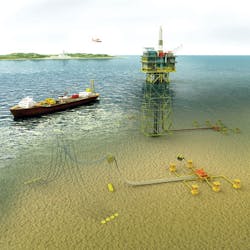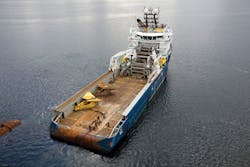Decommissioning subsea structures, moorings requires geotechnical considerations
Early focus on deconstructability helps lower cost, mitigate risk
Andy Small
Xodus
Decommissioning activities represent an increasingly significant proportion of North Sea offshore operations and associated engineering and will continue to do so beyond 2020. According to a recent survey by Oil & Gas UK, nearly £17 billion ($25 billion) is forecast to be spent on decommissioning approximately 79 fixed and floating installations and plugging 1,200 wells in the North Sea over the next 10 years. This represents around one-sixth of the circa 470 installations that will require decommissioning between now and 2050.
Nearly all offshore topsides facilities have associated subsea infrastructure. For example, wellhead protection structures, manifolds, and subsea isolation valves. These structures are designed to accommodate the specific requirements of the field, use a variety of different foundation types, and hence are essentially unique. As such, decommissioning of subsea structures and moorings presents significant challenges for engineers, particularly for structures installed prior to the 1992/1998 OSPAR agreements, where full decommissioning may not have been explicitly considered during the original design phase.
To overcome these challenges, understanding the geotechnical aspects and performing sufficient engineering studies to manage geotechnical risk will likely result in significant cost savings and operational efficiencies during execution of decommissioning projects.
Gravity-based structures
Assessing the recovery load is of particular importance for removal of gravity-based structures (GBS) to ensure lifting equipment and rigging is suitability sized, and that no shock loads are imparted on the system. The recovery load compared to the original as-installed submerged weight of the structure will usually be larger primarily due to soil-structure interaction effects. These include adhesion, soil strain rate effects, and negative pore pressure development which generate underbase resistance. The latter can be particularly significant for structures on soft clay seabeds, such as those located in the Witch Ground basin in the central North Sea.
Very soft clays under and immediately adjacent to structures can gain strength due to effects associated with structure installation and foundation loading. This increase is dependent on the stress history of the soil and factors related to the foundation loading and geometry.
Some gravity-based foundation systems feature skirts (embedded foundation elements) to increase the overall capacity of the foundation system. These skirts can also lead to substantial increases in recovery loads.
During the engineering phase of a decommissioning project a number of soil failure mechanisms must be considered to determine the likely magnitude of the recovery loads. In some cases, it may be that the soil plug could be recovered during extraction and recovery. Therefore, appropriate mitigations for this should be incorporated into operational planning.
Minor or major excavation prior to recovery may be required to reduce the recovery loads, in some cases. This excavation could be performed by handheld diver or ROV-mounted suction or jetting tools.
Larger scale excavation, for example, the excavation to skirt base level, may require mass-flow excavation, high-pressure water jetting, or similarly large equipment. The addition of buoyancy to reduce on-bottom weight may also be of benefit.
The use of excavation and buoyancy can potentially negate the requirement for large construction vessels and high-capacity cranage and allow the use of smaller, more readily available vessels.
Suction caissons and anchors
Removal of subsea structures founded on suction caissons can theoretically be achieved by reverse installation techniques. For instance, the application of overpressure (in place of suction) between the underside of the mud mat plate and the top of the soil plug (seabed inside the caisson).
Obtaining and reviewing original survey and design reports is key to understanding the likely behavior of the structure during recovery operations. For suction caissons and anchors, this will highlight the magnitude of likely overpressure, which must be overcome to allow extraction.
The accumulation of marine growth around valve work, corrosion, the ability of lifting eyes to take load, and the ability of weld seams as well as structural steelwork to resist the required overpressure can present a number of issues for recovery.
A pre-engineering general visual inspection should be conducted to determine the condition of the suction caisson with specific focus on the condition of pipework, hatches, ROV stabs, valves, and anodes. This will assist in determining if the structure can be removed by overpressure alone. A pressure test on the suction caisson would reveal if the caisson and soil plug have sufficient sealing abilities to retain overpressure for extraction.
Where suction caissons cannot be removed by overpressure alone, alternative approaches, such as the addition of buoyancy modules, application of a prescribed tension from a lift wire, and excavation techniques to reduce external skin friction, may require consideration. An alternative approach would be to leave the suction anchors in situ and cover with rock dump to prevent interaction with other users of the sea. Combining this with rock installation activities at nearby fields can make this a potentially cost-effective option.
Piled structures and moorings
Generally it is considered impractical to recover driven piled foundations and moorings due to the magnitude of the soil resistance which must be overcome to extract them from the seabed. As such, typical practice is to detach the structure from the foundation piles and recover in a single or a series of lifts. The remaining piles are subsequently cut at a specified depth below seabed level, depending on various factors. This cut can be performed either externally by excavating around the pile head or internally using internal dredging and cutting techniques.
A number of North Sea structures installed in the 1990s featured vibro-installed piles, and at least one of these subsea structures has been completely removed with reported success. It may be possible to extend this practice to allow complete removal of driven piles with this representing an interesting alternative to current practice.
Drag anchors
Where drag anchors have been used for moorings, the anchors and chain can normally be fully recovered using an anchor handling vessel with suitable bollard pull and reused elsewhere. As such, they are frequently used for temporary floating facilities such as flotels and semisubmersible drilling rigs. Recovery is usually achieved by the application of tension in the opposite direction to the setting direction at a high angle. In very soft seabed conditions, it is common to experience recovery loads higher than installation loads due to soil set-up effects.
An emerging challenge
The removal of subsea structures and moorings represent a significant cost to operators due to the nature of each decommissioning project. The potential for overall project cost increases due to unknowns is high, especially with regard to seabed uncertainty.
The bespoke nature of subsea infrastructure, the range of foundation options employed, and the various potential removal techniques raise issues that need to be addressed through a suitable level of decommissioning engineering.
In addition to these issues, an early focus on technical feasibility and deconstructability is required to realize opportunities for efficiency and cost reduction in conjunction with mitigating risk. The transfer of knowledge and experiences between operators and contractors will also be crucial to enable the industry to develop decommissioning practices further.
The design of new structures with a “design for decommissioning” philosophy together with knowledge gained from removal of existing structures should, in time, reduce the decommissioning burden on operators for new field developments.
Acknowledgment
Based on a paper presented at ISOPE 2015 held June 21-26, in Kona, Hawaii.
The author
Andy Small is a principal geotechnical engineer for Xodus based in Aberdeen. He holds a MEng in Civil Engineering Design and Management from the University of Dundee, UK. Before assuming his current position in 2013, he worked for offshore EPIC contractors and specialist offshore geotechnical consultancies.


